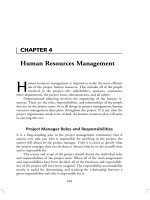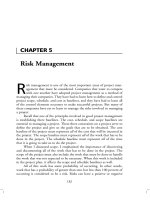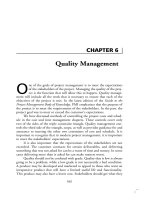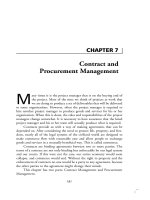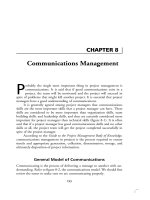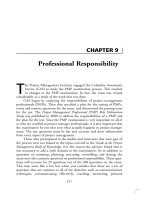Tài liệu Project Management Professional-Chapter 12b (Answer key) pdf
Bạn đang xem bản rút gọn của tài liệu. Xem và tải ngay bản đầy đủ của tài liệu tại đây (104.05 KB, 8 trang )
TIME MANAGEMENT
Answers to the following questions can be found in chapter 2, ‘‘Time Manage-
ment,’’ unless otherwise noted.
1. Answer: b
Note that activities in a calendar schedule start on the beginning of the time
period that they start on and end at the end of the time period that they finish
on. A two-day activity starts on May 5 and ends on May 6, ES and EF.
2. Answer: b
The free float or slack is the amount of time that an activity can be delayed
before it affects the schedule of any other activity. Activity F has free float but
activity D does not. Both have seven days of float, total float, or plain old float.
When calculating schedules and float with leads and lags, it is best to look at
the next activity with no lead or lag and, after determining the dates, change
them by the amount of the lead or lag.
3. Answer: d
The free float or slack is the amount of time that an activity can be delayed
before it affects the schedule of any other activity. Activity F has free float but
activity D does not. Both have seven days of float, total float, or plain old float.
4. Answer: a
Critical path is the list of activities that have zero total float. It is dangerous to
find the path that has the longest sum of the durations. Path A B D F H has a
duration of eight days but has a sum of the durations of ten days.
5. Answer: c
The late start for activity F is May 12. It has a late start that is calculated to be
two days before the late finish of activity D. With leads and lags it is best to
calculate the LS of the dependent activity, then the LF of the independent
activity, and then adjust the LF of the independent activity to consider the FS
lead.
6. Answer: b
325
326 Preparing for the Project Management Professional Certification Exam
The first work of the project is done on May 1, and the last work of the project
is finished on May 20.
7. Answer: c
There is a lead of two days associated with the finish-start relationship between
activities D and F. If the relationship were a normal FS relationship, the ES of
activity F would be May 7. A two day lead means it will start two days earlier,
or May 5.
8. Answer: b
Since activity F has seven days of float it can be delayed for as much as seven
days before it has any effect on the project completion.
9. Answer: a
The early finish date of activity A is the same as its start date and the start of
the project. Activities start on the beginning of the time period that work begins
and end on the end of the time period that work finishes. This activity takes
one day beginning in the morning of May 1 and finishing in the afternoon of
May 1.
10. Answer: c
The figure is called a precedence diagram. It is recognizable because boxes are
used to indicate the activities. The arrows in a precedence diagram indicate the
logical relationship between the activities. The information about the activity
is inside or around the box. An activity on arrow diagram will use circles to
indicate events and the activity information will be put on the arrows. The
Gantt chart has no logic shown normally (now available on some project man-
agement software). The length of the Gantt bar is proportional to a time scale
showing the duration of the activity. Although this diagram is also a network
diagram, there are many other network diagrams in the world. Precedence dia-
gram is a much better answer.
11. Answer: a
The finish-finish relationship in a precedence diagram says that the independent
activity must finish before the dependent activity is permitted to finish. In the
schedule, if the turkey took five hours to roast and the sweet potatoes took one
hour, the turkey would be scheduled to start at 1:00 .. and the sweet potatoes
would be scheduled to start at 5:00 .. Both would finish at 6:00 ..
The following table refers to questions 12 through 15.
9618$$ CH21 09-06-02 15:00:58 PS
327Time Management
o p ml EV SD CP EV CP SD CP VAR
A11110100
B 2 3 3 2.833333 0.166667
C 10 13 12 11.83333 0.5 11.83333 0.5 0.25
D555 5 0
E 3 6 4 4.166667 0.5 4.166667 0.5 0.25
F111 1 0
G 5 8 6 6.166667 0.5
H 9 13 10 10.33333 0.666667 10.33333 0.666667 0.444444
I55550500
Total 32.33333 Total 0.944444
Total 47.33333 Sqrt of Total 0.971825
Prob 66% sd 1 33.30516 31.36151
Prob 95% sd 2 34.27698 30.38968
Prob 99% sd 3 35.24881 29.41786
12. Answer: c
The expected value of the project is the expected value of each of the tasks that
are on the critical path, A C E H I. The approximate expected value is the sum
of each of these task’s optimistic, pessimistic, and four times the most likely
estimate divided by 6. When calculating the length of time that the project
takes, it is important that you remember to only include the critical path activi-
ties. Other activities in the schedule are done in parallel with the critical path
activities.
13. Answer: b
The 95% probability of the estimate is the expected value ע 2 standard devia-
tions of the total standard deviation of the critical path items. To total the
standard deviation, first square the value for each critical path item’s standard
deviation, add them up, and take the square root of the total.
14. Answer: b
The expected value for activity B is the sum of the optimistic, pessimistic, and
four times the most likely value, all divided by 6.
15. Answer: c
The standard deviation for activity B is the difference between the optimistic
estimate and the pessimistic estimate divided by 6.
16. Answer: d
9618$$ CH21 09-06-02 15:00:59 PS
328 Preparing for the Project Management Professional Certification Exam
Fast tracking a schedule is finding activities that can be done in parallel that
were originally scheduled to be done in sequence.
17. Answer: a
Crashing a schedule is improving the project completion date by any means
that is economical and feasible. In crashing a schedule an effort is made to find
the largest schedule reduction for the least additional cost.
18. Answer: d
The baseline schedule as well as the baseline budget and the baseline scope are
the original project plans plus or minus any approved changes. There are many
other terms used to describe schedules, but the definition given is the definition
of the baseline schedule and therefore the best answer.
19. Answer: b
Bar charts, also called Gantt charts, show activity start and end dates as well as
expected durations, but do not usually show dependencies. They are relatively
easy to read and are frequently used in management presentations. In a Gantt
chart there is a horizontal time scale. Activities are represented as bars above
the time scale in such a way that the length of the bar is proportional to the
elapsed time of the activity. The start of the activity is on the left side of the
bar and is above the date that it starts. The right hand side of the bar is located
over the finish of the activity.
20. Answer: c
The critical path activities are those activities that have zero float. There are
exceptions. When activities are forced to be done on specific dates (date con-
straints), it is possible to create negative float. When the project is resource
constrained the critical path may change due to resource constraints.
21. Answer: c
Resource leveling is a tool in most project management software and can also
be done manually. In resource leveling an attempt is made to reduce overutiliza-
tion of resources to their normal utilization.
22. Answer: b
At the end of two weeks this task is 75% complete. The PV was to be 4 person-
weeks, two people working full time for two weeks. The EV is therefore 3
person-weeks, .75 ן 4. The AC is 2 person-weeks. The cost performance index
is the EV / AC. CPI ס 3 person-weeks / 2 person-weeks ס 1.5.
9618$$ CH21 09-06-02 15:00:59 PS
329Time Management
23. Answer: b
Although total float is assigned to each of the tasks in the sequence, the total
float can be used by any of them and it can only be used one time by any of
them. If the tasks are A B C D E and each has one day of float, if A is delayed
by one day, the total float at B C D E reduces to zero.
24. Answer: c
Monte Carlo analysis is a simulation technique that assigns durations to tasks
in a schedule and then calculates the schedule information. It repeats this as-
signment and calculation many times and then reports statistical results, includ-
ing the percent of time a task is on the critical path.
25. Answer: a
Precedence diagramming method (PDM). This is a method of constructing a
project network diagram using nodes to represent the activities and connecting
them with arrows that show the dependencies. This technique is also called
activity-on-node (AON) and is the method used by nearly all project manage-
ment software packages.
Arrow diagramming method (ADM). This is a method of constructing a proj-
ect network diagram using arrows to represent the activities and connecting
them at nodes to show the dependencies. This technique is also called activity-
on-arrow (AOA) and, although less prevalent than PDM, is still the technique
of choice in some application areas.
26. Answer: d
The project schedule includes at least planned start and expected finish dates
for each detail activity. A schedule update is any modification to the schedule
information which is used to manage the project. Float is the amount of time
that an activity may be delayed from its start without delaying the project finish
date. Although the project’s budget is the time phased expenditure of the proj-
ect funds, it is not the project schedule and therefore the best answer.
27. Answer: d
Mandatory dependencies are those which are inherent in the nature of the work
being done. Discretionary dependencies are those which are defined by the
project management team. They should be used with care (and fully docu-
mented) since they may limit later scheduling options.
Resource requirements. The resources assigned to them will significantly influ-
ence the duration of most activities and the project itself.
9618$$ CH21 09-06-02 15:01:00 PS
330 Preparing for the Project Management Professional Certification Exam
Resource capabilities. The duration of most activities will be significantly in-
fluenced by the capabilities of the humans and material resources assigned to
them.
28. Answer: a
Critical path method (CPM) calculates a single, deterministic early and late
start and finish date for each activity based on specified, sequential network
logic and a single duration estimate. Program evaluation and review technique
(PERT) uses sequential network logic and a weighted average duration estimate
to calculate project duration. Although there are surface differences, PERT dif-
fers from CPM primarily in that it uses the distribution’s mean (expected value)
instead of the most likely estimate originally used in CPM and associates the
standard deviation of the estimate to allow the range of values and a probability
of occurrence to be calculated for the project.
29. Answer: b
The activity that has eighteen days of free float can be rescheduled without
having to reschedule any other activity in the project. If this activity is resched-
uled to start two weeks later, the resource will not be overutilized, and the
project will remain on schedule.
30. Answer: a
The person who is working on the task that has free float of five days can be
used on the task that is in trouble for five days without affecting the other task
schedules in the project. The person working on the task that has total float of
eight days can be used on the task that is in trouble, but since there is zero free
float for this task, there will have to be a rescheduling of other tasks to allow
this.
31. Answer: c
The logical analysis of the schedule often produces a preliminary schedule that
requires more resources during certain time periods than are available, or re-
quires changes in resource levels that are not manageable. Heuristics such as
‘‘allocate scarce resources to critical path activities first’’ can be applied to de-
velop a schedule that reflects such constraints. Resource leveling, because of the
limited availability of the resources, often results in a project duration that is
longer than the preliminary schedule.
32. Answer: b
The Guide to the PMBOK defines the lowest level of the work breakdown struc-
9618$$ CH21 09-06-02 15:01:00 PS
331Time Management
ture as the work package. It goes on to say that the work package is a unit of
work that can be assigned to a person or organization. It also says that the work
package can be broken down into tasks, and that tasks can be broken down
into activities.
33. Answer: c
When a risk is identified, budget and schedule time are identified and put into
the contingency reserve. If the risk actually occurs the money is used from the
contingency reserve and added to the operating budget of the project. The total
project budget contains the operating project budget or baseline, contingency
reserve, and the management reserve. The project budget baseline is increased
by the amount of the risk although the total project budget stays the same. The
schedule baseline is changed to reflect the new activities that have to be done.
34. Answer: d
The Guide to the PMBOK gives the following as inputs to the activity definition:
• Work breakdown structure.
• Scope statement.
• Historical information.
• Constraints
• Assumptions.
35. Answer: c
Fast tracking a project means that project tasks and activities are rescheduled
from being done in sequence to being done in parallel. Crashing a project
means doing anything practical that can be done to reduce the schedule. Fast
tracking only involves doing things in parallel that would have otherwise been
done in sequence.
36. Answer: b
The CPM or critical path method is used to determine the activities that have
zero float or close to zero float. These activities should be managed more care-
fully than other activities in the schedule since other activities not on the critical
path will have free float and total float that allows their schedules to be more
flexible.
37. Answer: c
PERT stands for program evaluation and review technique. In PERT each of
the activities has the optimistic, pessimistic, and most likely duration estimated.
9618$$ CH21 09-06-02 15:01:01 PS
332 Preparing for the Project Management Professional Certification Exam
A weighted average is then taken to estimate the expected value of the activity.
The weighted average is calculated by adding the optimistic, pessimistic, and
four times the most likely duration and dividing by 6. The standard deviation
of the activity can also be calculated by subtracting the optimistic duration
from the pessimistic duration and dividing by 6.
38. Answer: d
In the PERT calculation the standard deviation is calculated by squaring the
standard deviation for each of the activities on the critical path of the project,
adding them together, and then taking the square root. This is the standard
deviation of the project. Plus or minus two standard deviations from the ex-
pected value of the project duration will have a range of values such that the
project has a 95% probability of actually finishing within the dates calculated.
39. Answer: a
PERT is a probabilistic method used to determine the estimated project com-
pletion based on the statistical estimating of the project durations. CPM is a
deterministic method using specific values for activity and task durations.
40. Answer: c
The Guide to the PMBOK defines the lowest level of the work breakdown struc-
ture as the work package. It goes on to say that the work package is a unit of
work that can be assigned to a person or organization. The work package can
be broken down into tasks, and tasks can be broken down into activities.
9618$$ CH21 09-06-02 15:01:01 PS
TEAMFLY
Team-Fly
®



